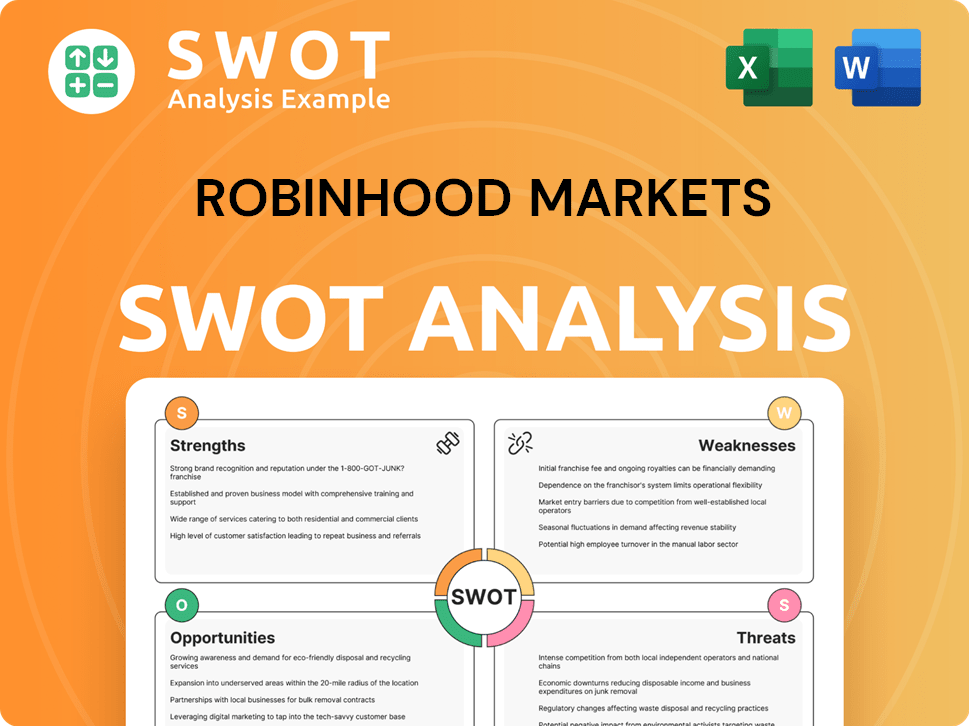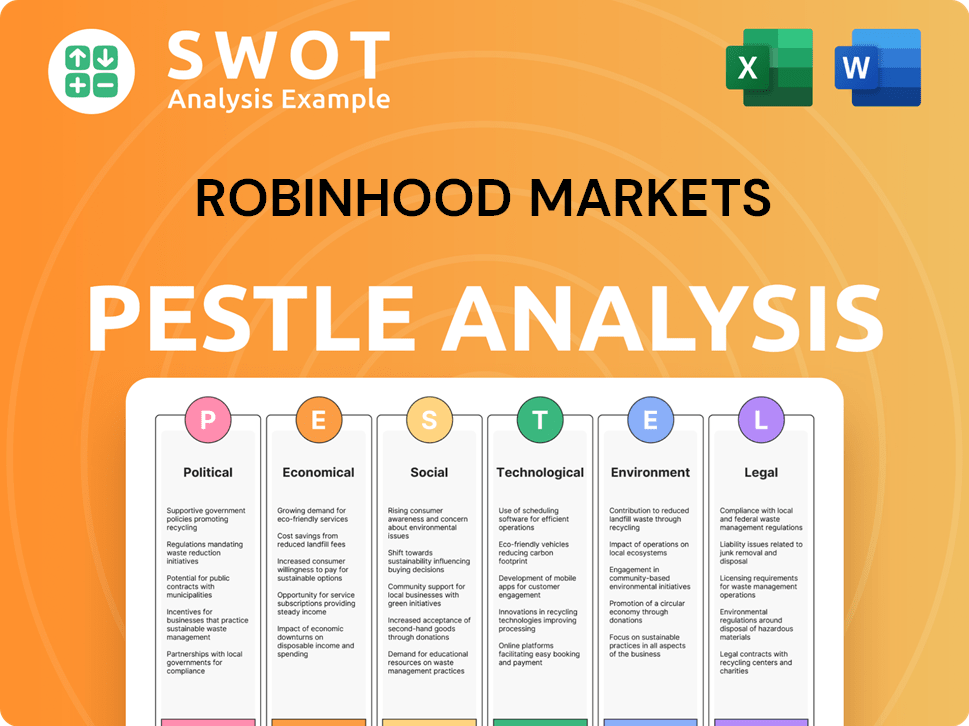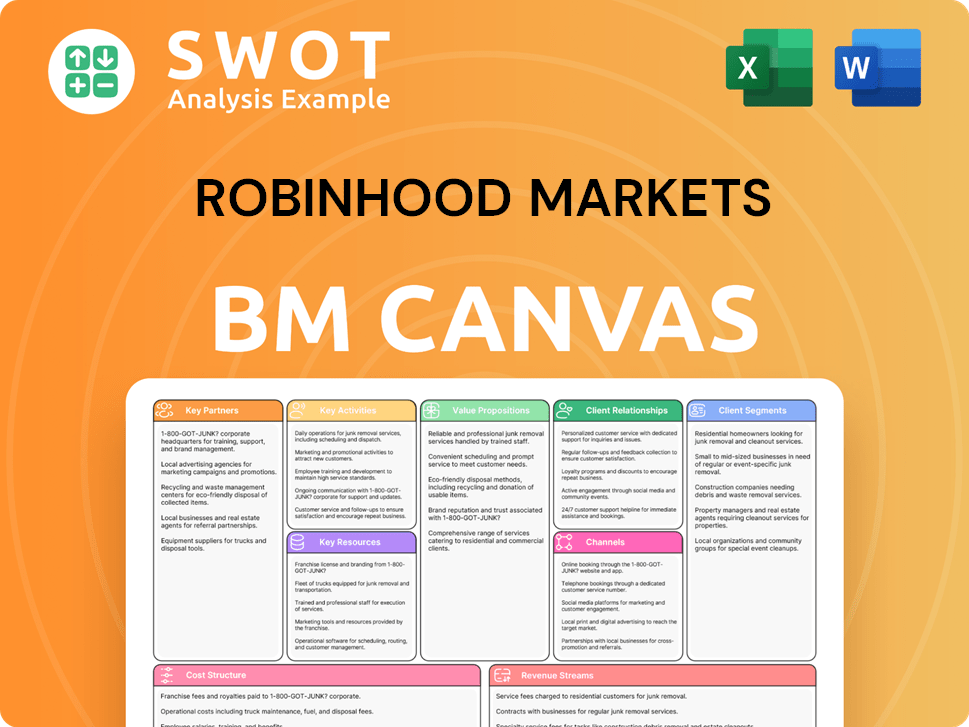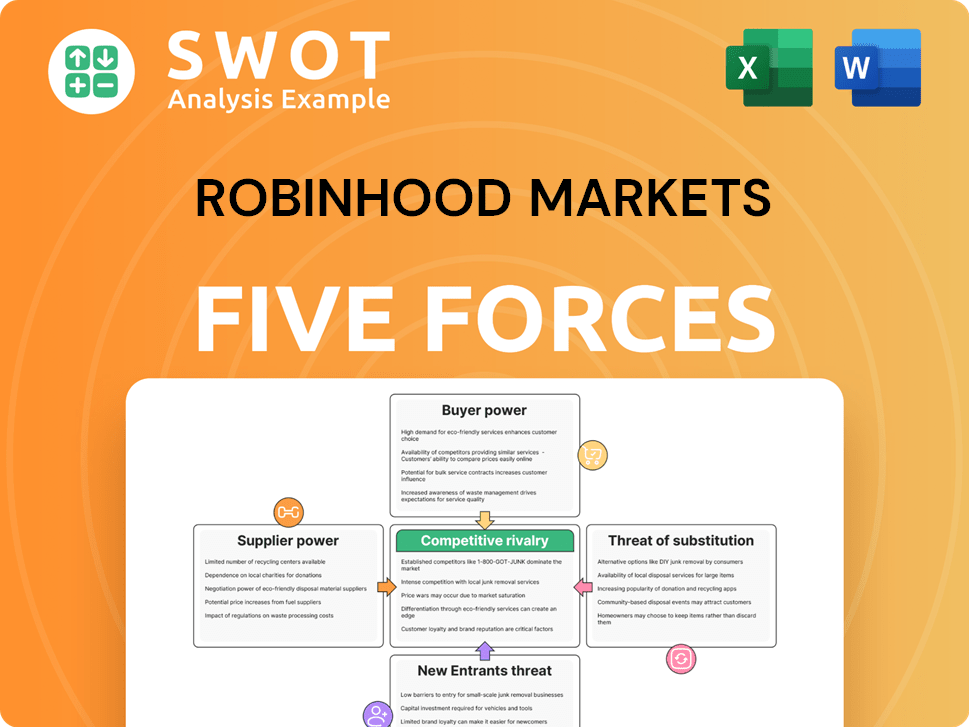Robinhood Markets Bundle
Can Robinhood Markets Continue to Disrupt the Financial World?
Founded in 2013, Robinhood Markets revolutionized the investment landscape with commission-free trading, attracting millions of users. From its inception, the company aimed to democratize finance, a mission that fueled its rapid growth and challenged traditional brokerage models. But what does the future hold for this Robinhood Markets SWOT Analysis?

This article delves into Robinhood's growth strategy, analyzing its ambitious expansion plans and the evolving financial technology landscape. We'll explore Robinhood's future prospects, examining its user acquisition strategies, revenue model, and the impact of regulatory changes. Understanding Robinhood's competitive landscape and market share is crucial for investors and strategists alike, making this analysis essential for anyone interested in the future of stock trading and the investing platform.
How Is Robinhood Markets Expanding Its Reach?
The expansion initiatives of Robinhood Markets are primarily centered on broadening its product offerings and exploring new geographical markets. This strategic approach aims to diversify revenue streams, attract a wider customer base, and maintain a competitive edge in the rapidly evolving financial technology sector. These initiatives are crucial for long-term growth and sustainability.
A significant aspect of Robinhood's expansion involves enhancing its existing platform. This includes introducing advanced charting tools and educational resources to improve user experience and encourage deeper engagement. Such enhancements are designed to retain users and attract new ones by providing a more comprehensive and user-friendly trading environment. The company's strategy also includes the addition of new coins and features to cater to growing interest in digital assets.
Robinhood's growth strategy also includes international expansion, although specific timelines and target markets remain largely undisclosed. The company's focus on innovation and user experience is a key driver of its expansion plans, ensuring it remains competitive in the financial technology landscape. For a deeper understanding of Robinhood's customer base, consider exploring the Target Market of Robinhood Markets.
Robinhood launched Robinhood Retirement in late 2022, offering IRA accounts. This initiative provides a 1% match on contributions for eligible customers. This move aims to attract and retain users looking for long-term investment solutions beyond active trading, expanding the platform's appeal.
The company continues to expand its cryptocurrency offerings. In 2024, Robinhood Crypto expanded its services to Nevada, bringing its total operational states to seven. This expansion reflects the growing interest in digital assets and the company's commitment to providing access to these markets.
Robinhood is enhancing its platform with advanced charting tools and educational resources. These improvements aim to improve user experience and encourage deeper engagement. The goal is to make the platform more user-friendly and provide tools that support informed investment decisions.
Robinhood has signaled intentions for international expansion, though specific timelines and target markets are not yet disclosed. This strategic move is designed to diversify the company's revenue streams. The company has not yet announced any specific international markets.
Robinhood's expansion strategy focuses on product diversification and market expansion. The company aims to attract a broader customer base and remain competitive in the financial technology landscape. These strategies are driven by the need to diversify revenue streams beyond payment for order flow.
- Launch of retirement accounts to attract long-term investors.
- Expansion of cryptocurrency offerings to meet growing demand.
- Enhancement of the platform with advanced tools and educational resources.
- Potential international expansion to tap into new markets.
Robinhood Markets SWOT Analysis
- Complete SWOT Breakdown
- Fully Customizable
- Editable in Excel & Word
- Professional Formatting
- Investor-Ready Format

How Does Robinhood Markets Invest in Innovation?
The innovation and technology strategy of Robinhood Markets is crucial for its sustained growth. The company leverages its mobile-first platform and data analytics to improve user experience and introduce new products. This approach is central to attracting new users and increasing engagement among existing customers.
Robinhood invests heavily in in-house development, continuously refining its app and expanding its backend infrastructure. This supports a growing user base and increasing transaction volumes, which is essential for scaling its operations. Automation is a key component, streamlining trading processes and customer support to reduce costs and boost efficiency.
The company is also exploring the integration of cutting-edge technologies, particularly in areas like AI for personalized financial insights and enhanced security features. These advancements directly contribute to growth objectives by making investing more accessible and user-friendly.
Robinhood's mobile app is its primary interface, designed for ease of use and accessibility. The platform's intuitive design attracts a broad user base, particularly younger investors. This mobile focus is a key differentiator within the Owners & Shareholders of Robinhood Markets.
Data analytics plays a crucial role in understanding user behavior and preferences. Robinhood uses data to personalize the user experience, offering tailored investment recommendations and insights. This approach helps retain users and encourages increased trading activity.
Robinhood prioritizes in-house development to maintain control over its technology and quickly adapt to market changes. This allows for rapid iteration and the ability to introduce new features and products efficiently. Continuous updates are a hallmark of the platform.
Automation streamlines trading processes and customer support, reducing operational costs. This includes automated trade execution, which enhances efficiency and minimizes delays. Automation is key to scaling operations.
The integration of AI enhances the user experience by providing personalized financial insights and recommendations. Enhanced security features, such as multi-factor authentication and fraud detection, protect user accounts and data. These technologies are critical for building trust.
Features like fractional shares and recurring investments make investing more accessible to a wider audience. These features lower the barriers to entry, allowing users to invest with smaller amounts of capital. This increases engagement and attracts new users.
Robinhood's technological advancements directly contribute to its growth strategy. These innovations attract new users, increase engagement, and enable the efficient scaling of new product offerings. The company's focus on technology is a key driver of its future prospects.
- User Acquisition: The platform's user-friendly interface and innovative features attract a large number of new investors.
- Engagement: Continuous updates and new features encourage existing users to remain active on the platform.
- Scalability: The robust technology infrastructure supports a growing user base and increasing transaction volumes.
- Competitive Advantage: Technology allows Robinhood to differentiate itself in the competitive financial technology market.
Robinhood Markets PESTLE Analysis
- Covers All 6 PESTLE Categories
- No Research Needed – Save Hours of Work
- Built by Experts, Trusted by Consultants
- Instant Download, Ready to Use
- 100% Editable, Fully Customizable

What Is Robinhood Markets’s Growth Forecast?
The financial outlook for Robinhood reflects a shift towards profitability and sustainable growth. The company is moving beyond its initial rapid expansion phase. This transition involves strategic initiatives aimed at diversifying revenue streams and improving operational efficiency.
For the full year 2023, Robinhood reported total net revenues of $1.87 billion, marking a 37% increase compared to 2022. A significant milestone was achieving its first profitable year on a GAAP basis, with a net income of $52 million. This financial performance demonstrates the company's ability to generate substantial revenue and manage its expenses effectively.
Looking ahead, analysts anticipate continued improvements in Robinhood's financial performance. In the first quarter of 2024, the company reported total net revenues of $618 million, representing a 40% year-over-year increase. Transaction-based revenues saw a 46% increase, reaching $329 million, primarily driven by strong growth in crypto and options trading. The net income for Q1 2024 was $157 million, a considerable improvement from a net loss in the previous year. This growth highlights the success of Robinhood's strategies to increase revenue and improve profitability.
Robinhood's revenue growth is a key indicator of its success. Total net revenues for 2023 were $1.87 billion, a 37% increase from the previous year. In Q1 2024, total net revenues reached $618 million, a 40% year-over-year increase, driven by strong performance in crypto and options trading.
Robinhood has achieved significant milestones in profitability. The company recorded its first profitable year on a GAAP basis in 2023, with a net income of $52 million. Q1 2024 saw a substantial improvement, with a net income of $157 million, demonstrating the company's ability to manage costs and increase earnings.
Transaction-based revenues are a significant part of Robinhood's income. In Q1 2024, these revenues increased by 46% to $329 million, largely due to growth in crypto and options trading. This shows the importance of these trading activities for the company's revenue generation.
Robinhood is focused on growing interest-earning assets and diversifying its revenue streams. This includes its Gold subscription service and retirement accounts. These initiatives are expected to contribute to the company's long-term financial goals, supporting its Revenue Streams & Business Model of Robinhood Markets.
Robinhood's financial strength is supported by a robust balance sheet. The company holds $6.1 billion in cash and cash equivalents, providing a solid foundation for future growth initiatives. This strong financial position allows Robinhood to invest in new products, expand its services, and navigate market fluctuations effectively.
- Strong Revenue Growth: Demonstrates the effectiveness of the company's business model and market strategies.
- Improved Profitability: Reflects efficient cost management and successful revenue diversification.
- Strategic Investments: Highlights the company's commitment to long-term growth and innovation.
- Robust Balance Sheet: Provides financial flexibility for future expansion and market resilience.
Robinhood Markets Business Model Canvas
- Complete 9-Block Business Model Canvas
- Effortlessly Communicate Your Business Strategy
- Investor-Ready BMC Format
- 100% Editable and Customizable
- Clear and Structured Layout

What Risks Could Slow Robinhood Markets’s Growth?
The path of Robinhood Markets towards sustainable growth is fraught with potential risks and obstacles. The company faces a complex landscape shaped by intense competition and regulatory pressures. Navigating these challenges will be critical for achieving its long-term financial goals and maintaining its position in the financial technology sector.
Market dynamics and technological advancements continue to evolve, requiring constant adaptation from the company. Internal challenges, such as scaling customer support and ensuring regulatory compliance, could impact its ability to maintain user satisfaction and meet its growth targets. Effective risk management and strategic agility are essential for mitigating these threats and capitalizing on emerging opportunities.
The company's revenue model, significantly reliant on payment for order flow (PFOF), is under scrutiny. Regulatory changes in this area could substantially affect its financial performance. Furthermore, the emergence of new technologies and shifting consumer preferences demand continuous innovation and adaptation to stay competitive.
The investing platform faces stiff competition from established brokerages and newer fintech firms. These competitors continuously seek to attract users with innovative features and competitive pricing. Maintaining market share requires ongoing strategic initiatives.
Regulatory changes, particularly concerning PFOF, could significantly impact Robinhood's revenue. The company has faced scrutiny and fines from regulators in the past. Compliance with evolving regulations is a constant challenge.
New technological innovations can rapidly shift industry dynamics, requiring continuous adaptation. The company must stay ahead of the curve to remain competitive. This includes embracing new technologies and anticipating market trends.
Scaling customer support and ensuring compliance as the user base grows can be challenging. These constraints can impact user satisfaction and regulatory standing. Efficient resource management is crucial.
Cybersecurity threats pose a constant risk to user data and financial assets. Robust security measures and proactive threat management are essential. Protecting user information is paramount.
Consumer preferences for financial services are constantly changing. The company must adapt its offerings to meet evolving demands. This includes offering new products and improving user experience.
The company has faced multiple regulatory actions, including a $57 million fine in December 2020 by the SEC for failing to seek best execution. In December 2024, regulators continue to scrutinize PFOF practices.
Competitors like Fidelity and Charles Schwab offer commission-free trading and have substantial resources. Traditional brokerages are investing heavily in technology to compete with fintech firms. The market share battle is ongoing.
Platform outages and technical glitches have impacted user trust. The company needs to invest in robust technology infrastructure to ensure reliability. Improving system stability is a priority.
The company's revenue model is heavily reliant on PFOF, which faces regulatory risk. The company's financial performance is subject to fluctuations in market conditions and trading volumes. Diversifying revenue streams is crucial.
Robinhood Markets Porter's Five Forces Analysis
- Covers All 5 Competitive Forces in Detail
- Structured for Consultants, Students, and Founders
- 100% Editable in Microsoft Word & Excel
- Instant Digital Download – Use Immediately
- Compatible with Mac & PC – Fully Unlocked

Related Blogs
- What are Mission Vision & Core Values of Robinhood Markets Company?
- What is Competitive Landscape of Robinhood Markets Company?
- How Does Robinhood Markets Company Work?
- What is Sales and Marketing Strategy of Robinhood Markets Company?
- What is Brief History of Robinhood Markets Company?
- Who Owns Robinhood Markets Company?
- What is Customer Demographics and Target Market of Robinhood Markets Company?
Disclaimer
All information, articles, and product details provided on this website are for general informational and educational purposes only. We do not claim any ownership over, nor do we intend to infringe upon, any trademarks, copyrights, logos, brand names, or other intellectual property mentioned or depicted on this site. Such intellectual property remains the property of its respective owners, and any references here are made solely for identification or informational purposes, without implying any affiliation, endorsement, or partnership.
We make no representations or warranties, express or implied, regarding the accuracy, completeness, or suitability of any content or products presented. Nothing on this website should be construed as legal, tax, investment, financial, medical, or other professional advice. In addition, no part of this site—including articles or product references—constitutes a solicitation, recommendation, endorsement, advertisement, or offer to buy or sell any securities, franchises, or other financial instruments, particularly in jurisdictions where such activity would be unlawful.
All content is of a general nature and may not address the specific circumstances of any individual or entity. It is not a substitute for professional advice or services. Any actions you take based on the information provided here are strictly at your own risk. You accept full responsibility for any decisions or outcomes arising from your use of this website and agree to release us from any liability in connection with your use of, or reliance upon, the content or products found herein.